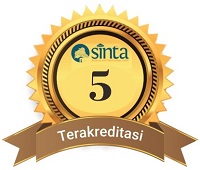ESTIMASI KALORI EXPENDITURE BERDASARKAN ACCELEROMETER ACTIGRAPH DAN ERGOCYCLE
Abstract
Keywords
Full Text:
PDFReferences
Altini, M., Penders, J., Vullers, R., & Amft, O. (2015). Estimating energy expenditure using body-worn accelerometers: A comparison of methods, sensors number and positioning. IEEE Journal of Biomedical and Health Informatics, 19(1), 219-226. https://doi.org/10.1109/JBHI.2014.2313039
Arvidsson, D., Fridolfsson, J., & Börjesson, M. (2019). Measurement of physical activity in clinical practice using accelerometers. Journal of Internal Medicine, 286(2), 137-153. https://doi.org/10.1111/joim.12908
Bassett, D. R., & John, D. (2010). Use of pedometers and accelerometers in clinical populations: validity and reliability issues. Physical Therapy Reviews, 15(3), 135-142. https://doi.org/10.1179/1743288X10Y.0000000004
Beamon, B. D. (2019). UAB Digital Commons Validity of Actigraph GT3X Accelerometer in Determining Energy Expenditure.
Beltz, N. M., Gibson, A. L., Janot, J. M., Kravitz, L., Mermier, C. M., & Dalleck, L. C. (2016). Graded Exercise Testing Protocols for the Determination of VO 2 max: Historical Perspectives, Progress, and Future Considerations . Journal of Sports Medicine, 2016, 1-12. https://doi.org/10.1155/2016/3968393
Binns, A., Gray, M., & Di Brezzo, R. (2015). Thermic effect of food, exercise, and total energy expenditure in active females. Journal of Science and Medicine in Sport, 18(2), 204-208. https://doi.org/10.1016/j.jsams.2014.01.008
Bisson, M., Alméras, N., Dufresne, S. S., Robitaille, J., Rhéaume, C., Bujold, E., Frenette, J., Tremblay, A., & Marc, I. (2015). A 12-week exercise program for pregnant women with obesity to improve physical activity levels: An open randomised preliminary study. PLoS ONE, 10(9), 1-17. https://doi.org/10.1371/journal.pone.0137742
Brazeau, A. S., Beaudoin, N., Bélisle, V., Messier, V., Karelis, A. D., & Rabasa-Lhoret, R. (2016). Validation and reliability of two activity monitors for energy expenditure assessment. Journal of Science and Medicine in Sport, 19(1), 46-50. https://doi.org/10.1016/j.jsams.2014.11.001
Chaput, J. P. (2014). Sleep patterns, diet quality and energy balance. Physiology and Behavior, 134(C), 86-91. https://doi.org/10.1016/j.physbeh.2013.09.006
Chen, K. Y., & Bassett, D. R. (2005). The technology of accelerometry-based activity monitors: Current and future. Medicine and Science in Sports and Exercise, 37(11 SUPPL.). https://doi.org/10.1249/01.mss.0000185571.49104.82
Chow, E. J., Lynch, J. B., Zerr, D. M., Riedo, F. X., Fairchok, M., Pergam, S. A., Baliga, C. S., Pauk, J., Lewis, J., & Duchin, J. S. (2024). Annals of Internal Medicine. Annals of Internal Medicine, 177(5), 689. https://doi.org/10.7326/L23-0449
Cunningham, J. (1991). Original Body composition a synthetic review general prediction of energy expenditure : as a determinant and a proposed. Am J Clin Nutr, 54(6), 963-969.
Dannecker, K. L., Sazonova, N. A., Melanson, E. L., Sazonov, E. S., & Browning, R. C. (2013). A comparison of energy expenditure estimation of several physical activity monitors. Medicine and Science in Sports and Exercise, 45(11), 2105-2112. https://doi.org/10.1249/MSS.0b013e318299d2eb
Dowd, K. P., Harrington, D. M., & Donnelly, A. E. (2012). Criterion and Concurrent Validity of the activPALTM Professional Physical Activity Monitor in Adolescent Females. PLoS ONE, 7(10). https://doi.org/10.1371/journal.pone.0047633
Drew, M., Vlahovich, N., Hughes, D., Appaneal, R., Burke, L. M., Lundy, B., Rogers, M., Toomey, M., Watts, D., Lovell, G., Praet, S., Halson, S. L., Colbey, C., Manzanero, S., Welvaert, M., West, N. P., Pyne, D. B., & Waddington, G. (2018). Prevalence of illness, poor mental health and sleep quality and low energy availability prior to the 2016 summer Olympic games. British Journal of Sports Medicine, 52(1), 47-53. https://doi.org/10.1136/bjsports-2017-098208
Dunstan, D. W., Kingwell, B. A., Larsen, R., Healy, G. N., Cerin, E., Hamilton, M. T., Shaw, J. E., Bertovic, D. A., Zimmet, P. Z., Salmon, J., & Owen, N. (2012). Breaking up prolonged sitting reduces postprandial glucose and insulin responses. Diabetes Care, 35(5), 976-983. https://doi.org/10.2337/dc11-1931
Farooqi, I. S., & O'Rahilly, S. (2006). Genetics of obesity in humans. Endocrine Reviews, 27(7), 710-718. https://doi.org/10.1210/er.2006-0040
Herman Hansen, B., Børtnes, I., Hildebrand, M., Holme, I., Kolle, E., & Anderssen, S. A. (2014). Validity of the ActiGraph GT1M during walking and cycling. Journal of Sports Sciences, 32(6), 510-516. https://doi.org/10.1080/02640414.2013.844347
Kossi, O., Lacroix, J., Ferry, B., Batcho, C. S., Julien-Vergonjanne, A., & Mandigout, S. (2021). Reliability of ActiGraph GT3X+ placement location in the estimation of energy expenditure during moderate and high-intensity physical activities in young and older adults. Journal of Sports Sciences, 39(13), 1489-1496. https://doi.org/10.1080/02640414.2021.1880689
Leenders, N. Y., Sherman, W. M., & Nagaraja, H. N. (2006). Energy expenditure estimated by accelerometry and doubly labeled water: Do they agree? Medicine and Science in Sports and Exercise, 38(12), 2165-2172. https://doi.org/10.1249/01.mss.0000235883.94357.95
Most, J., & Redman, L. M. (2020). Impact of calorie restriction on energy metabolism in humans. Experimental Gerontology, 133(February), 110875. https://doi.org/10.1016/j.exger.2020.110875
Oudegeest-Sander, M. H., Eijsvogels, T. H. M., Verheggen, R. J. H. M., Poelkens, F., Hopman, M. T. E., Jones, H., & Thijssen, D. H. J. (2012). Impact of physical fitness and daily energy expenditure on sleep efficiency in young and older humans. Gerontology, 59(1), 8-16. https://doi.org/10.1159/000342213
Romieu, I., Dossus, L., Barquera, S., Blottière, H. M., Franks, P. W., Gunter, M., Hwalla, N., Hursting, S. D., Leitzmann, M., Margetts, B., Nishida, C., Potischman, N., Seidell, J., Stepien, M., Wang, Y., Westerterp, K., Winichagoon, P., Wiseman, M., & Willett, W. C. (2017). Energy balance and obesity: what are the main drivers? Cancer Causes and Control, 28(3), 247-258. https://doi.org/10.1007/s10552-017-0869-z
Sholahuddin, A., Jajat, Damayanti, I., Sultoni, K., Suherman, A., Rahayu, N., Ruhayati, Y., & Zaky, M. (2024). Klasifikasi Aktifitas Fisik Berbasis Data Accelorometer ActivPal dan ActiGraph: Metode Analisis dengan Machine Learning. Jurnal Dunia Pendidikan, 4(2), 857-869. https://jurnal.stokbinaguna.ac.id/index.php/JURDIP
Viera, A. J., Tuttle, L., Olsson, E., Gras-Najjar, J., Gizlice, Z., Hales, D., Linnan, L., Lin, F. C., Noar, S. M., & Ammerman, A. (2017). Effects of physical activity calorie expenditure (PACE) labeling: Study design and baseline sample characteristics. BMC Public Health, 17(1), 1-8. https://doi.org/10.1186/s12889-017-4710-0
DOI: https://doi.org/10.37311/jjsc.v7i1.30040
Refbacks
- There are currently no refbacks.

Jambura Journal of Sports Coaching (p-ISSN: 2654-3435 | e-ISSN: 2656-0437) is licensed under a Creative Commons Attribution-ShareAlike 4.0 International License.
Jambura Journal of Sports Coaching has been indexed by:
-------------------------------------------------- -------------------------------------------------- -------------------------------------------------- -----------------------------
-------------------------------------------------- -------------------------------------------------- -------------------------------------------------- -----------------------------
BERKOLABORASI DENGAN
















_-_Copy.jpg)